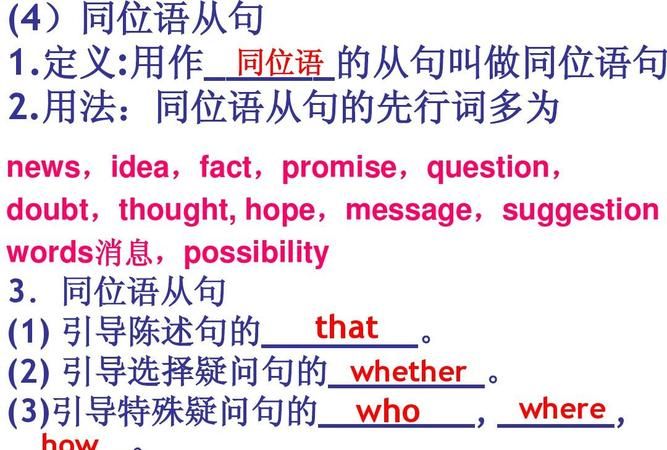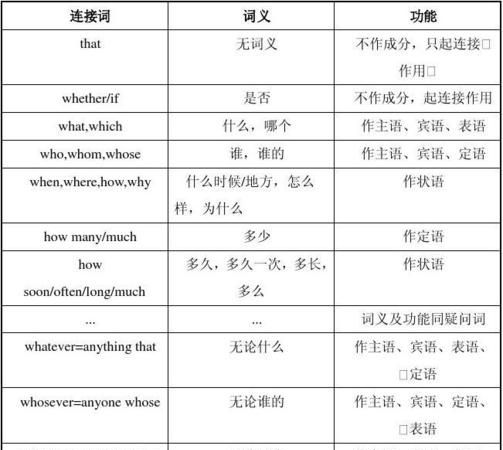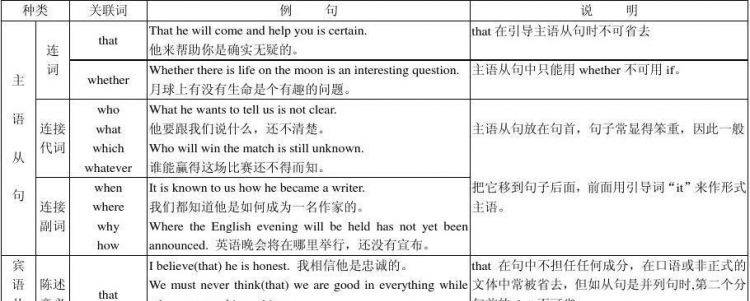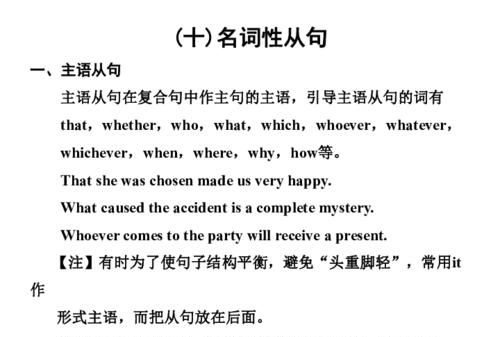本文目录
英语同位语从句例句100句
The news that a Pakistan girl stood up for education and was nearly killed by the Taliban surprised the whole world.
被同位语从句修饰的词往往是抽象的,例如 hope,news,fact,idea,question等等。
There is no question that teenagers need rules .
毫无疑问,青少年需要规则。
Malala, a seventeen-year-old girl , became the youngest person ever to be given a Nobel Peace Prize.
Nobel Peace Prize = 诺贝尔和平奖
将下面两句哈合成简洁的一句话。
1. Mark Zuckerberg delivered a speech at Harvard University.
2. He is the founder of Facebook.
【答案】
Mark Zuckerberg, the founder of Facebook , delivered a speech at Harvard University.
【同位语的一般特征】
一般情况下,同位语一般都紧紧跟在被修饰的词后面。
【同位语的分隔】
同位语跟被修饰词也可以被一些词隔开,例如 for example,such as,including等等。
She has won many prizes, including the Nobel Peace Prize .
【同位语从句】
由句子做同位语,是名词性从句的一种。
Lang Lang, a world-class pianist, is such a promising young man.
promising = 有前途的
【 同位语从句形式一:that + 句子 】
This early success gave his father high hopes that Lang Lang would become a great pianist .
【练习】
用英语表达:我们队赢了比赛的消息太棒了!
“It's great news that our team won the match!”
注意:that不能省略。
【 同位语从句形式二:whether + 句子 】
Whether he would become a great pianist worried / troubled Lang Lang a lot.
trouble = 使麻烦
a lot = much = 非常
注意:同位语从句中,表示“是否”只能用whether。
【 同位语从句形式三:其他引导词 + 句子 】
that 和 whether 最常见,例如when, where, who 等
Hawking was exploring the question of where the boundaries of the Universe are .
霍金探索过宇宙的边界。
The news that a Pakistan girl stood up for education and was nearly killed by the Taliban surprised the whole world.
一则巴基斯坦女孩为教育权利发声而差点被塔利班杀害的消息震惊了全世界。
尝试用本节课所学的同位语和同位语从句来表达下面这段话:
1. 一则小女孩获得诺贝尔和平奖的新闻震惊了全世界。
The news that a girl won the Nobel Peace Prize surprised the whole world.
2. 17岁巴基斯坦少女马拉拉为妇女和儿童教育发声而差点被塔利班杀害。
Malala, a seventeen-year-old girl , was nearly killed by the Taliban because of the declaration for women and children education.
3. 幸运地是,她活了下来,并继续关心一些儿童是否能上学的问题。
Luckily, she survived and continued to care about the question whether some children could go to school .

同位语从句的概念及用法总结
同位语从句属于名词性从句,大多由连词that引导,常常跟在fact, idea, opinion, news, hope, belief等名词后面.同位语从句一般用来解释或说明这些名词的具体含义或内容,在逻辑上表现为同位关系.
They are familiar with the opinion that all matter consists of atoms.
他们很熟悉这一观点,所有的物质都是由原子构成的
从先行词来看
同位语从句与名词之间该名词是需要做特殊说明的名词.idea, fact, news, hope, belief, suggestion, word, thought, doubt, truth, possibility, promise, order等有一定内涵的名词
They were delighted at the news that their team had won.
当听到他们的球队赢了的消息时,他们欣喜若狂.
定语从句与先行词---可以是名词?代词?主句的一部分或是整个主句
The factory(that)we visited yesterday is a chemical one.
2、从引导词that来看
引导词that在同位语从句中是连词,只起连接作用,无具体词义,that不可省略;
that在定语从句中是关系代词,它在从句中充当一定成分---主语或宾语,有具体词意,作宾语时还可以省略.试比较:
The factory(that)we visited yesterday is a chemical one.我们昨天参观的那家工厂是化工厂.
The news that he will leave for Shanghai is true.他将要去上海的消息是真的.
(that只起连接从句的作用,所以此句是同谓语从句)
3.从句的功能与性质
定语从句是形容词从句,其作用相当于一个形容词,对其先行词的修饰或限制;
同位语从句是名词从句,其作用相当于一个名词,对前面抽象名词的进一步的说明和解释The news that our team has won the game was true. 我们队赢了那场比赛的消息是真的?
(同位语从句,补充说明news到底是一个什么消息?)
The news that he told me yesterday was true. 昨天他告诉我的那个消息是真的?
(定语从句,news在从句中作told的宾语?)
4. 引导词在从句担当的成分
有些引导词如how, whether, what可以引导同位语从句,但不能引导定语从句?
定语从句的引导词that在从句中充当一定的成分,可作主语、宾语、
同位语从句中的引导词that在从句只起连接作用,不作任何句子成分.
1. A plane is a machine that can fly. 飞机是一种能飞的机器.
2. The fact that they didn't finish the work has to be faced. 必须面对事实他们没有完成工作.
例1中的引导词that在从句中充当句子成分,作从句的主语,故为定语从句;
例2中的that起连接作用,引导从句解释fact的内容,不作任何句子成分,为同位语从句.
5.引导词担当成分时的省略
引导定语从句的关联词在从句中作宾语或状语时,可以省略或被其他词代替;介词+which
同位语从句的引导词一般不能省略,更不能被代替.
1. The news that she heard is true. 她听到的消息是真的.
2. The news that she will go abroad is true. 她将出国这消息是真的.
例1是定语从句,that可省略;例2是同位语从句,that不能省略.
3. The reason why he was chosen is unknown. 他为什么被选上的原因还是不清楚 (定)
4. The idea why he was chosen attracted our attention.
他为什么会被选上,这一想法引起我们的注意. (同位语从句)
四、同位语从句与其所修饰的名词之间是一种同位关系,二者之间存在逻辑上的系表关系,可用“主+系+表”结构来表示.例如:
The news that he won the first place is true. 他赢得冠军的那个消息是真的.
上句若用“主+系+表”结构来表示,则是:
The news is that he won the first place. 消息是他赢得了冠军.
意思合理,系表结构成立,故为同位语从句.
五、定语从句所修饰、限定的先行词可以是各类名词,可以有复数形式;而同位语从句一般都与抽象名词同位,一般没有复数形式.
六、由when, why, where引导的定语从句分别修饰或说明表示时间、原因或地点的词,
但它们引导的同位语从句一般不和表示时间或地点的词同位.例如:
定1. I still remember the day when I first came to Beijing. 我仍然记得初次来北京的那天.
同2. I have no idea when she will be back. 我不知道她何时回来.
定3. This is the house where I lived two years ago. 这是我两年前住的房子.
同4. The question where we shall have a meeting hasn't decided. 我们到什么地方去开会,这个问题没有决定.
同位语从句:that 有些名词的后面可以接that引导的同位语从句:We came to the decision that we must act at once. 我们做出决定:我们必须立即行动.There was little hope that he would survive. 他幸存的希望很小
同位语从句:whether whether可以引导同位语从句,而定语从句不能用whether作为引导词. He hasn’t made the decision whether he will go there他还没有做出决定是否去那里. I have small doubt whether he is suitable for the job. 他是否适合这件工作我有点怀
同位语从句:what what可以引导同位语从句,而定语从句不能用what作为引导词
I have no idea what he is doing now. 我不知道他现在在干什么
同位语从句:how how可以引导同位语从句,而定语从句不能用how作为引导词
It’s a question how he did it. 那是一个他如何做了此事的问题
同位语从句: who, whom, which, when, where, why用来引导同位语从句
The question who should do the work requires consideration.
谁该干这项工作,这个问题需要考虑.
She raised the question where we could get the fund. 她提出这个问题我们到哪儿去搞这笔资
同位语从句和定语从句的区别
1同位语从句和先行词是同等的关系;而定语从句是用来修饰先行词,是从属的关系
2)that在同位语从句中没有词义,不充当句子成分;而定语从句中充当主语、宾语等成分
3)whether, what, how可以用来引导同位语从句;而它们不能用来引导定语从句.
4)一 从词义角度看问题 who, whom, which, when, where, why用来引导同位语从句是保持原来疑问词的含义;它们用来引导定语从句时,不具有疑问词的含义二 从搭配角度看问题who, whom, which, when, where, why用来引导定语从句时对应性很强,如: 先行词是“人”,引导词用“who”等,而它们引导同位语从句是先行词通常是“question, idea, doubt等

同位语从句和定语从句的区别
同位语从句与定语从句的区别
1、同位语从句与前面的名词是同位关系,即说明它前面名词的内容;而定语从句与前面的名词是修饰与被修饰关系,即限定它前面的名词范围,或补充一些情况。如:
The news that l hove passed the exam is true.我通过了考试这一消息是真的。
(同位语从句,即从句所表达的意思就是前面名词的内容。)
The news that he told me just now is true.他刚才告诉我的消息是真的。
(定语从句,从句对前面名词起修饰限制作用,即“他告诉我的”那个消息,而不是别的消息。)
2、引导同位语从句的that是连词,在从句中不充当任何成份,而引导定语从句的that是关系代词,除起连接作用外,还在从句中充当主语、宾语或表语等。如:
The idea that computers can recognize human voices surprises many people.
计算机能够识别人的声音的想法使许多人感到惊奇。
(that在从句中不充当任何成份。)
The idea that he gave surprises many people.
他提出的观点令许多人感到吃惊。
(that在从句中作gave的宾语。)

什么是同位语从句
同位语从句和定语从句一样通常都放在由名词充当的先行词后面,
且其先行词和关联词特点与定语从句先行词及关联词特点十分相似,极易混淆,不过两者的区别还是十分明显的。
1.
从句性质不同
同位语从句属于名词性从句,是用来进一步解释或补充说明前面的名词;而定语从句是用来说明先行词的性质或特征,起修饰或限制的作用,与先行词的关系是修饰与被修饰的关系,从句相当于形容词。
例1:The
plan
that
you
will
go
there
next
week
has
to
be
changed.你准备下周去那里的计划得改变.
析:认真分析语境含义及句子结构可知,从句为The
plan的具体内容,因此该句为同位语从句。
例2:The
news
that
he
told
me
was
false.他告诉我的消息是假的。
析:认真分析语境含义和句子结构可知,从句是用来修饰The...同位语从句和定语从句一样通常都放在由名词充当的先行词后面,
且其先行词和关联词特点与定语从句先行词及关联词特点十分相似,极易混淆,不过两者的区别还是十分明显的。
1.
从句性质不同
同位语从句属于名词性从句,是用来进一步解释或补充说明前面的名词;而定语从句是用来说明先行词的性质或特征,起修饰或限制的作用,与先行词的关系是修饰与被修饰的关系,从句相当于形容词。
例1:The
plan
that
you
will
go
there
next
week
has
to
be
changed.你准备下周去那里的计划得改变.
析:认真分析语境含义及句子结构可知,从句为The
plan的具体内容,因此该句为同位语从句。
例2:The
news
that
he
told
me
was
false.他告诉我的消息是假的。
析:认真分析语境含义和句子结构可知,从句是用来修饰The
news的,
因此该句为定语从句。
2.关联词作用不同
定语从句的关联词在从句中作主语、宾语、时间状语、地点状语和原因状语等,而同位语从句的关联词在从句中不担任成分。
例1:The
plan
that
I”ll
stay
there
for
a
week
can”t
come
true.我要在那儿呆一周的计划不能实现。
析:分析句子成分可知,that在从句中不作任何成分,因此该句为同位语从句。
例2:The
plan
that
he
raised
was
reasonable.他提出的计划合理。
析:that在从句中作宾语,因此该句为定语从句。
3.同位语从句先行词不同
同位语从句的先行词就是被同位语从句修饰的名词,因为它和同位语从句在内容上相同,因此常为一些体现一定内容的名词,如:hope,
plan,
fact,
news,
problem,
truth,
idea,
information等,此时同位语从句具体介绍这些名词的内容。同位语从句的先行词虽然体现同位语从句的内容,但在同位语从句中并不充当成分

以上就是关于同位语从句修饰的名词 ,英语同位语从句例句100句的全部内容,以及同位语从句修饰的名词 的相关内容,希望能够帮到您。
